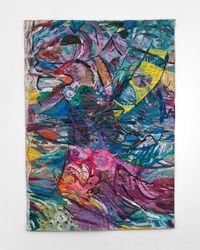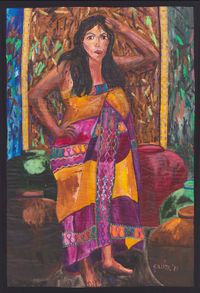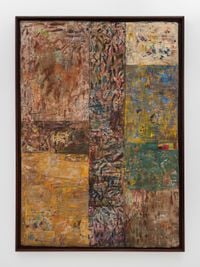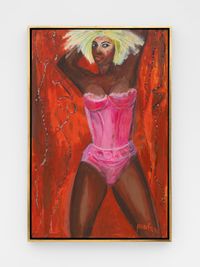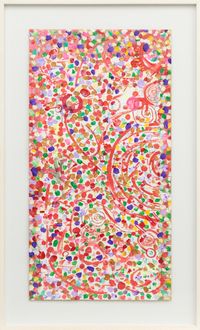Pacita Abad is a celebrated painter and activist renowned for her prismatically coloured canvases and mixed-media techniques that defy categorisation.
Read MoreAbad is best remembered as an itinerant artist whose extensive travels were a powerful source of inspiration, fueling her material investigations and increasingly abstract artworks, and galvanising her to the socio-political plight of women across the globe. Abad passed away in 2004 at the age of 58, with over 60 international solo shows to her name.
Abad was born in 1946 in Basco, in the Philippines' Northern Province of Batanes. Following in her family's footsteps, she studied political sciences at the University of the Philippines before fleeing to San Francisco due to her activism against the Fernando Marcos regime. There, she studied Asian history at Lone Mountain College (later the University of San Francisco) and became involved in the local art scene, beginning to paint. In 1973, she undertook a year-long pilgrimage from Turkey to the Philippines, a journey that marked the beginning of her life-long affair with travel.
Upon her return to America, Abad pursued painting at the Corcoran School of Art in Washington, D.C. and later at The Art Students League in New York City. Over the next three decades, the artist travelled to over 50 countries, where she stepped herself in the local arts and traditions, absorbing the stylistic influences of African mask-making, Indonesian batik, Javanese wayang puppetry, Tibetan thangka, and Yemeni architecture. A self-identified woman of colour, Abad embedded herself in the diverse epistemologies of the Global South, becoming an advocate for the empowerment of indigenous cultures.
Pacita Abad devised her innovative trapunto technique through vast experiments with textiles and painting. The technique lent her canvases a quilted texture and sculptural dimension, and allowed her to incorporate her immediate environment into the work, embellishing the surface with feathers, rocks, mirrors, and seashells that attested to the specificity of her encounter.
Her early subject matter was equally exuberant: tropical flora and fauna, tribal masks and underwater paradises. Abad's unrestrained use of colour epitomised her sense of optimism and far-ranging interests.
Pacita Abad's sojourns across the globe brought her face-to-face with some of the late 20th century's geopolitical crises, from Cambodian refugee camps on the Thai border to the downfall of the Suharto regime in Indonesia. Abad's socio-political portraits bear witness to the violence and oppression of peoples, to the modern-day slavery and sexual exploitation of women, and to the migrant experiences of modern America.
Pacita Abad died in Singapore, whilst undergoing chemotherapy for lung cancer, after completing her final project, the Alkaff Bridge (2003—2004): a 55-meter pedestrian walkway adorned with her signature circle motifs, which the artist gifted to the city.
Pacita Abad's art has been shown in group exhibitions and solo exhibitions internationally with the Pacita Abad Art Estate, established in 2005, continuing to preserve her legacy and present her work around the world.
Solo exhibitions include: I Thought the Streets Were Paved With Gold, Jameel Arts Centre, Dubai (2021); Life in the Margins, Spike Island, Bristol (2020); I Have One Million Things to Say, Museum of Contemporary Art and Design, Manila (2018); Circles in My Mind, Cultural Centre of the Phillipines, Manila (2004); Exploring the Spirit, National Gallery of Indonesia, Jakarta (1996); Artists + Community, National Museum For Women in the Arts, Washington D.C. (1994); Oriental Abstractions, Hong Kong Arts Centre, Hong Kong (1986); Pacita Abad: A Phillipine Painter Looks at the World (1984).
Group exhibitions include: Sweat, Haus der kunst, Munich (2021); Garden of Six Seasons, Para Site, Hong Kong (2020); Suddenly Turning Visible: Art and Architecture in Sea, 1969—89, Singapore National Gallery, Singapore (2019); Global Woman Project 2000—2007, International Museum of Women, San Francisco (2003); Talk Back, Bronx Museum, New York (1997); Contemporary Art of the Non-Aligned Countries, National Gallery of Indonesia, Jakarta (1995); The International Art Show For The End Of World Hunger, Barbican Centre, London (1988); Second Asian Art Show, Fukukoa, Japan (1985).
The website for the Pacita Abad Art Estate (founded in 2005) can be found here and Pacita Abad's Instagram can be found here.
Amy Weng | Ocula | 2021
